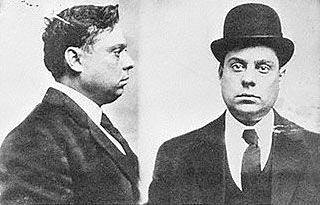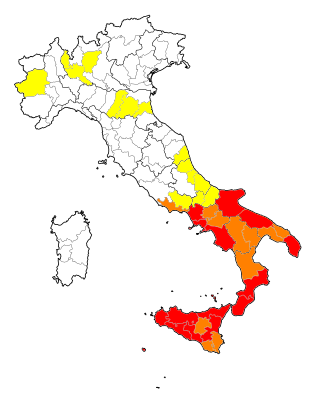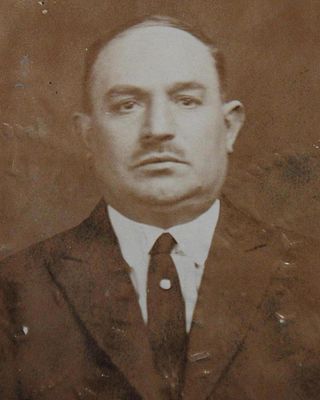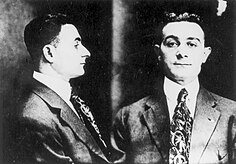The Castellammarese War was a bloody power struggle for control of the Italian-American Mafia that took place in New York City, New York, from February 26, 1930 until April 15, 1931, between partisans of Joe "The Boss" Masseria and those of Salvatore Maranzano. The war was named after the Sicilian town of Castellammare del Golfo, the birthplace of Maranzano. Maranzano's faction won and divided New York's crime families into the Five Families; Maranzano declared himself capo di tutti i capi. However, Maranzano was murdered in September 1931 on orders of Lucky Luciano, who established a power-sharing arrangement called the Commission, a group of Mafia families of equal stature, to avoid such wars in the future.
Nicolò Terranova, also known as Nicholas "Nick" Morello, was one of the first Italian-American organized crime figures in New York City he succeeded Giuseppe Morello as boss of the then Morello Gang in 1909 and was succeeded by Vincenzo Terranova in 1916. Along with his half-brother Giuseppe Morello and brothers Ciro and Vincenzo Terranova, he founded the Morello crime family, and was later one of the participants in the Mafia-Camorra War of 1915–17.
Manfredi "Al" or "Alfred" Mineo was an Italian American mobster, who headed a strong American Mafia crime family during the Castellammarese War. Mineo's organization would eventually become the present-day Gambino crime family.

The Morello crime family was one of the earliest crime families to be established in the United States and New York City. The Morellos were based in Manhattan's Italian Harlem and eventually gained dominance in the Italian underworld by defeating the rival Neapolitan Camorra of Brooklyn. They were the predecessors of what eventually became known as the Genovese crime family.

Ignazio Lupo, also known as Ignazio Saietta and Lupo the Wolf, was a Sicilian American Black Hand leader in New York City during the early 1900s. His business was centered in Little Italy, Manhattan, where he ran large extortion operations and committed other crimes including robberies, loan-sharking, and murder. By the start of the 20th century, Lupo merged his crew with others in the South Bronx and East Harlem to form the Morello crime family, which became the leading Mafia family in New York City.

Criminal organizations have been prevalent in Italy, especially in the southern part of the country, for centuries and have affected the social and economic life of many Italian regions since at least the 19th century. There are six major native mafia-like organizations that are heavily active in Italy. The oldest and most powerful of these organizations, having begun to develop between 1500 and 1800, are the 'Ndrangheta from Calabria, the Cosa Nostra from Sicily and the Camorra based in Campania. In addition to these three long-established organizations, there are also three other significantly active organized crime syndicates that were founded in the 20th century: the Stidda of Sicily, and the Sacra Corona Unita and Società foggiana, both from Apulia.
Stefano Ferrigno was an American mobster of Sicilian origin who led an important Italian criminal gang in the 1920s. Ferrigno was murdered along with Alfred Mineo during the so-called Castellammarese War.
Salvatore "Toto" D'Aquila was an early Italian-American Mafia boss in New York City of the D'Aquila crime family, what would later become known as the Gambino crime family.
Alfonso Sgroia, also known as "The Butcher" was a New York gang member who became a hitman for the Navy Street gang connected to the Camorra in New York City.
A crime family is a unit of an organized crime syndicate, particularly in Italian organized crime and especially in the Sicilian Mafia and Italian American Mafia, often operating within a specific geographic territory or a specific set of activities. In its strictest sense, a family is a criminal gang, operating either on a unitary basis or as an organized collection of smaller gangs. In turn, a family can be a sole "enterprise" or part of a larger syndicate or cartel. Despite the name, most crime families are generally not based on or formed around actual familial connections, although they do tend to be ethnically-based, and many members may in fact be related to one another.
The Mafia–Camorra War was a gang war in New York City that lasted from 1915–1917. On one side was the originally Sicilian Morello crime family of Manhattan; on the other side were gangs originally from Naples and the surrounding Campania region, based in Navy Street in Brooklyn and Coney Island referred to as the Camorra. The fight over the control of the New York rackets started after the killing of Giosue Gallucci, the undisputed King of Little Italy, and his son on May 17, 1915. The trials that followed in 1918 completely smashed the Camorra gangs; the protection that they enjoyed was demolished from the testimonies of their own men. It was the end of the Camorra in New York and the rise in power of American-based Sicilian Mafia groups.

Gaetano Reina was an Italian-American gangster. He was an early American Mafia boss who was the founder of what has for many years been called the Lucchese crime family in New York City. He led the family until his murder on February 26, 1930, on the orders of Joe Masseria.

Alessandro Vollero was a New York mobster and a high-ranking member of the Neapolitan Camorra Navy Street gang in Brooklyn. Vollero served as a lieutenant to gang boss Pellegrino Morano during the Mafia-Camorra War of 1916.
Rocco Valenti was a New York City gangster and prominent member of the Camorra in New York during the early 1910s.
Pellegrino Morano (1877–unknown) was the head of a group of Neapolitan criminals with roots in the Camorra based in Coney Island, where he owned the Santa Lucia restaurant, which was often used as the headquarters for their gang, known as the Coney Island gang. He is also known as Marano.

Ralph Daniello (1886–1925), also known as "The Barber", was a New York criminal who belonged to the Brooklyn Navy Street Gang and participated in a major gang slaying in the Mafia-Camorra War. In 1917, Daniello eventually became an informant for the New York police and helped destroy the Camorra crime gangs in Brooklyn. Daniello's testimony helped to clear up 23 homicide cases in New York.
The 116th Street Crew, also known as the Uptown Crew, is a group of Italian-American mobsters within the Genovese crime family. In the early 1960s, Anthony Salerno became one of the most powerful capos in the family. Salerno based the crew in the Palma Boys Social Club located at 416 East 115th Street in East Harlem, Manhattan. By the late 1970s and early 1980s, the 116th Street Crew had absorbed and initiated many former members of the vicious East Harlem Purple Gang, an Italian-American murder for hire and drug trafficking gang operating in 1970s Italian Harlem and acting generally independent of the Mafia.
Antonio Paretti, also known as Tony Paretti or Tony the Shoemaker, was a Camorra gangster. He was a member of the Brooklyn-based Coney Island gang in New York City, serving as the right-hand man of Pellegrino Morano.

Giosuè Gallucci, also known as Luccariello, was a crime boss of Italian Harlem in New York City affiliated with the Camorra. He dominated the area from 1910–1915 and was also known as the undisputed "King of Little Italy" or "The Boss", due to his power in the criminal underworld and political connections. He held strict control over the policy game, employing Neapolitan and Sicilian street gangs as his enforcers.

Nicolo "Cola" Schiro was an early Sicilian-born New York City mobster who, in 1912, became the boss of what later become known as the Bonanno crime family.











